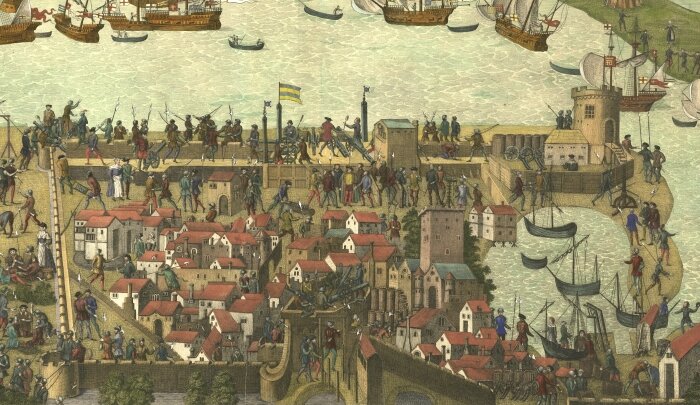Did you know... The Greater Excommunication
The ‘new’ font of 1508
On 6 April 1508 the Greater Excommunication - that had resulted in the closure of our church of St Thomas for 58 years - was lifted by the Pope. Do you know the reason for this ban in the first place?
On January 9th 1450, Adam de Moleyns, Bishop of Chichester since 1445, was dragged from the Domus Dei (on the site of the Garrison Church) where he was staying and ‘cruelli kilde’. Bishop Moleyns had just resigned as Keeper of the King’s Privy Seal (December 1449), in order to concentrate on his diocese but also to go on pilgrimage. He was en route to Rome via Portsmouth when he was killed; he had agreed to pay the troops there as he passed through.
Whodunnit, and why? There are various theories: i) the Bishop brought insufficient funds to pay the troops about to embark for France; ii) Richard, Duke of York, paid men to assassinate the Bishop, as the Duke believed the Bishop had discredited him; iii) the Bishop was blamed for his part in the loss of much of Normandy to the French, and fear of the consequent drastic reduction in Portsmouth’s trade incensed the people. Whoever did the deed - soldiers, sailors, hired killers - it was the population of Portsmouth who suffered the punishment of Greater Excommunication. Pope Nicholas V deprived them of the sacraments, ‘benefit of clergy’ (i.e. the exemption of clergy and nuns from the jurisdiction of the civil courts) and entry to the church of St Thomas; in addition they suffered the destruction or removal of their font, no burials in consecrated ground, no church bell, and - after death - Hell! This situation lasted for 58 years. In the 1490s, Henry VII began to develop Portsmouth as a naval base to counter the danger from the French. This may well have led to the lifting of the ban by Pope Julius II.
Cowdray engraving showing Moleyns Chapel
At 7am on 6 April 1508, the church bell tolled. The citizens, led by their Vicar, Robert Adam, gathered outside the closed doors of St Thomas’s. From there, they were ordered to go to the Domus Dei. Once there, they were symbolically driven out with rods and ordered to retrace their steps ‘with naked feet and legs, prostrate themselves in prayers, seek penance and absolution and admission to the church’ – the route perhaps along Penny (maybe originally Penance?) Street.
Portsmouth map 1584 with Moleyns chapel
Then they had to return to the scene of the crime, prostrate themselves, and recite the Lord’s Prayer 15 times and the Apostles’ Creed 3 times, during which the commissioners recited seven penitential psalms and renewed the mock beating with their ‘rods’. Only then could the people return and enter St Thomas’s Church with lighted candles - symbolising their physical and spiritual return. The citizens had to erect a cross at the murder scene, then build a small chapel there. On Good Fridays, the parishioners were to visit the chapel with bare feet and legs and give an offering. On the anniversary of the murder, one member of each family had to attend a Requiem Mass at the new chapel, bearing a lit candle. In 1508, the Perpendicular font in St Thomas’s church - now to be found in the North Ambulatory - replaced the original font.
During the Reformation (circa 1538), the small chapel became a store house; the Cowdray engraving, based on a picture of the sinking of the Mary Rose in July 1545, includes the building.
Presumably then these customs ceased, and today there is no visible trace of the building.



